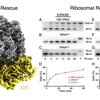
Contact Information
University of Illinois
419 Roger Adams Lab B-4
600 S Mathews Ave
Urbana, IL 61801
Research Interests
Research Topics
Bioinformatics, Drug Discovery, Enzymology, Host-Pathogen Interactions, Molecular Evolution, Protein Synthesis, Protein-Nucleic Acid Interactions, RNA Biology, Toxins
Research Description
Molecular mechanisms of biological conflicts
In biology, there are two fundamental conflicts: one is between organisms, and the other is between organisms and viruses. During the conflicts, organisms employ a variety of offensive and defensive weaponry to gain the upper hand. My research group mainly focuses on study of defensive systems employed by bacteria in both conflicts.
Conflicts between organisms. The main goal of the conflicts between bacteria appears to acquire a larger share of nutrition. To achieve this, certain bacteria (attack cells) synthesize a variety of biological toxins to kill their neighbors to eliminate competition. To survive, the bacteria targeted by toxins (target cells) employ a variety of defensive mechanisms to neutralize the toxins imposed on them. If the damage done by an invading toxin is irreversible, the only chance of survival is direct inhibition of the toxin. If the damage inflicted by an invading toxin is reversible, however, an alternative approach of indirect inhibition via repair might allow the target cell to survive. The clash between a ribotoxin and an RNA repair system appears to be such an example of indirect confrontation. My research group is interested in discovery of new RNA repair systems as well as mechanistic understanding of how RNA repair is carried out.
Conflicts between organisms and viruses. Infection of a bacterial cell by a phage triggers a variety of defensive responses within the cell. In our view, the first response is from a primary antiphage system, which is either a ubiquitous DNA restriction-modification (R-M) system or a CRISPR-Cas. The goal of the primary response is to kill phage via degrading phage DNA. If this fails, all hell breaks loose. Recent studies indicate the presence of widespread antiphage systems via abortive infection (Abi) in bacteria, and they appear to be activated as the secondary response to phage infection. While the ways of killing phages by the primary antiphage systems are limited, there are many ways for an infected cell to commit suicide (e.g., Abi). It is possible that there exist more than 100 different antiphage systems via Abi. My research group is interested in discovering new antiphage systems as well as mechanistic understanding of how an infected cell commits suicide via Abi.
An interesting interplay between these two conflicts. Because of its essential role and universal conservation in all organisms, protein translation machinery is one of the biggest battlefields for the conflicts. This is illustrated by studies, carried out by Kaufmann and colleagues several decades ago, on the conflict between T4 phage and E. coli cells. Specifically, certain E. coli strains encode PrrC, a ribonuclease that is usually sequestered by a R-M system under normal conditions. Upon T4 phage infection, however, the infected cell releases PrrC from the R-M system and cleaves its own tRNALys to commit suicide. T4 phage does not want E. coli cell to die. It therefore employs a RNA repair system, composed of two proteins named Pnkp and Rnl, to reverse the damage done by PrrC. Therefore, T4 Pnkp-Rnl is the first discovered RNA repair system, and PrrC is likely to be one of the first discovered antiphage systems that employ Abi mechanism.
Education
B.S. and M.S. 1986 Nankai University
Ph.D. 1995 University of Washington
Postdoc. 1996-99 Harvard University
Additional Campus Affiliations
External Links
Highlighted Publications
Representative Publications
Tian Y, Zeng F, Raybarman A, Fatma S, Carruthers A, Li Q, Huang RH* (2022) Sequential rescue and repair of stalled and damaged ribosome by bacterial PrfH and RtcB. PNAS 119:e2202464119.
Fatma S, Chakravarti A, Zeng X, Huang RH* (2021) Molecular mechanisms of the CdnG-Cap5 antiphage defense system employing 3’,2’-cGAMP as the second messenger. Nat. Commun. 12:6381.
Chakravarti A, Selvadurai K, Shahoei R, Lee H, Fatma S, Tajkhorshid E, Huang RH* (2018). Reconstitution and substrate specificity for isopentenyl pyrophosphate of the antiviral radical SAM enzyme viperin. J. Biol. Chem. 293: 14122-14133.
Wang P, Selvadurai K, Huang RH* (2015) Reconstitution and structure of a bacterial Pnkp1–Rnl–Hen1 RNA repair complex. Nat. Commun. 6:6876.
Selvadurai K, Wang P, Seimetz J, Huang RH* (2014) Archaeal Elp3 catalyzes tRNA wobble uridine modification at C5 via a radical mechanism. Nat. Chem. Biol. 10: 810-812
Wang P, Chan CM, Christensen D, Zhang C, Selvadurai K, Huang RH* (2012) Molecular basis of bacterial Hen1 activating the ligase activity of bacterial Pnkp for RNA repair. PNAS 109:13248-13253.
Recent Publications
Tian, Y., Zeng, F., Raybarman, A., Fatma, S., Carruthers, A., Li, Q., & Huang, R. H. (2022). Sequential rescue and repair of stalled and damaged ribosome by bacterial PrfH and RtcB. Proceedings of the National Academy of Sciences of the United States of America, 119(29), Article e2202464119. https://doi.org/10.1073/pnas.2202464119
Fatma, S., Chakravarti, A., Zeng, X., & Huang, R. H. (2021). Molecular mechanisms of the CdnG-Cap5 antiphage defense system employing 3′,2′-cGAMP as the second messenger. Nature communications, 12(1), Article 6381. https://doi.org/10.1038/s41467-021-26738-2
Huang, R. H. (2019). Ribotoxins Kill Cells by Chopping off the Head of tRNAs. Structure, 27(11), 1613-1614. https://doi.org/10.1016/j.str.2019.10.009
Castelle, C. J., Brown, C. T., Anantharaman, K., Probst, A. J., Huang, R. H., & Banfield, J. F. (2018). Biosynthetic capacity, metabolic variety and unusual biology in the CPR and DPANN radiations. Nature Reviews Microbiology, 16(10), 629-645. https://doi.org/10.1038/s41579-018-0076-2
Chakravarti, A., Selvadurai, K., Shahoei, R., Lee, H., Fatma, S., Tajkhorshid, E., & Huang, R. H. (2018). Reconstitution and substrate specificity for isopentenyl pyrophosphate of the antiviral radical SAM enzyme viperin. Journal of Biological Chemistry, 293(36), 14122-14133. https://doi.org/10.1074/jbc.RA118.003998

